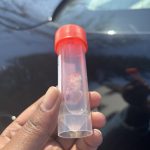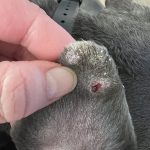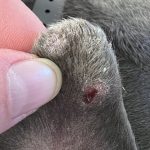Hello,
Well, that’s not a preferred response to a new treatment. If you think she is acting normally then I don’t think she needs to be seen right away. I am at the clinic Sunday. And we are here Saturday too. You can call the clinic anytime and ask to speak to the charge tech. The hey can help right away. Please also leave me a message so I can follow up next week. If you need me in between email me at krista@pawbly.com.
Dr. Magnifico – My captain (5 month old GSD) started vomiting this afternoon. Threw up all the food he had in his stomach at the time and has since thrown up 8 other times. Mostly foamy mucus and liquid. Had diarrhea once so far that was very gassy and liquidy. He can’t hold any water down. He is now just laying down. I can hear his stomach gurgle every once in a while. I’m held up in the kitchen with him. This started around 6pm, it’s now almost 11pm. I don’t know if I should wait through the night or go to ER now. Help please.
Comments
Dr Magnifico,
Ivy started the Quattro preventative on Sunday. She started having diarrhea on Tuesday and it’s still an issue today. She is playing fine and eating normal. Should I be concerned? How long should I wait til I bring her in?
Comments
I have a question on a 9 year old boxer, back in January he was treated for respiratory cough, he was treated once, didn’t go away. Had to take him back to vet, and treated again was better but it continue for a few more weeks and finally went away. Now our boxer really isn’t eating properly will not eat dry food at all ,only if we give him people food. We rescue dogs and have 2 other dogs so we only have so much of budget.
Any suggestions of what it could be or what minimal testing we can do?
Comments
Not sure if you answer this but had a question about our 5 year old cat. Since November she has been experiencing a fair amount of nasal discharge. We tried to rounds of antibiotics, a flush, and the vet searched for a polyp using a spade hook on her soft pallet while she was sedated. The vet was unable to see a polyp and the nasal xray didn’t show much either. A month later we saw no improvement on the nasal and over the past ten days our poor cat has been breathing terribly. When she is standing up and moving around it is clear her breathing is obstructed and it sounds like she is snoring. We have noticed a large decrease in her nasal discharge but her breathing is just awful. She is still eating and drinking as normal. We have been referred to internal medicine in St. Louis but aren’t excited to spend $2-3K for a CT Scan and scoping. Is it possible the poly behind her soft pallet has grown since they first looked for it or could a polyp be some where else? Do you think a CT scan us necessary or should the scope do the trick. We love our cat but are reluctant to spend $3K on her only to find out the couldn’t do anything to help her.
Comments
Needing help with a blocked kitty! My baby Latte, 8 months old, by all appearances, seems to have a blockage. She has been vomiting it’s all just been clear or pale yellow with white foam no blood no worms. We don’t know if what she ate is passable, and it’s been 2 days since she’s eaten anything but a lick of food. She isn’t drinking much water either, and she hasn’t gone #2 since this all started to boot. We have an appointment tomorrow t have her x-rayed but I have no idea how much it will cost. I’m really nervous I won’t be able to avoid surgery if it’s a blockage. What are my chances it’s just really bad constipation, or if they can remove blockage without surgery? Or if surgery is needed how can I get financial help for it?
Comments
My dog has a patch on the tip of her ear that looks like a build up of something. It is dry and hard. I started picking at it and the hair started coming part. What is this and how do I help?
She also has other spots on her body that are just dry and thinning hair. Is there anything I can do to help with hair loss/thinning? Anything topical? We were told she may have an allergy to chicken so she is on a sensitive diet.
Comments
I’m a loving pet owner with a 12 yr old Morkie (who is dying from prostate cancer$ and a Yorkie puppy (who we got before the cancer diagnosis). Interested in how to know signs of imminent death or the need to euthanize. Also, tips on keeping the Yorkie’s “puppy-ism” from causing the Morkie to be overwhelmed with fear, discontent, concern, feeling outcast.
Comments
My dog Nick is going through heart worm treatment and I have a few questions…
he is 12 days post 1st injection as of today. He is on Prednisone once daily, and has Gabapentin 300mg which I give as needed.
he seems to shiver quite a bit – is he cold or feeling uncomfortable? I understand that the worms are dying and disintegrating. Is that painful for him? Does it cause pressure in his lungs? That is where this process takes place – is that correct?
I keep him a small room with me and in a crate when unsupervised. If I am in the kitchen he is leashed and laying on the floor. Only goes upstairs at night. I am giving him enrichment toys however he did eat (literally) half of one and had to go to vet to vomit the toy-my fault, I know he eats things. He is on a short leash for potty breaks. The heart worm society recommends having the dog sit at each stage for going outside, this little man will do anything for a treat and this works great for him. Does this seem like a good approach?
Thoughts or suggestions are appreciated.
Thank you!

















Hello,
I’m sorry to hear about Captain. In puppies we worry about parvovirus, intestinal parasites, foreign bodies and eating something that doesn’t agree with them. With your pup I am not as concerned about the first two.
I am at the clinic first thing. We will fit you in.
Dr Magnifico
Thank you for following up. He is back to his normal self this morning. He has eaten fine as well. I guess something did not agree with him.